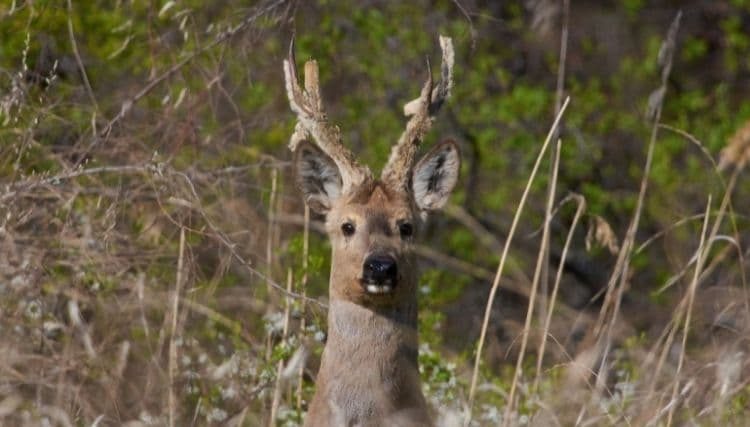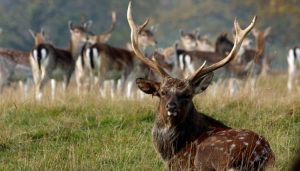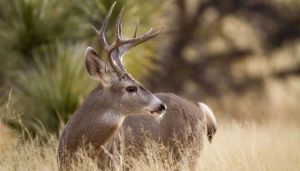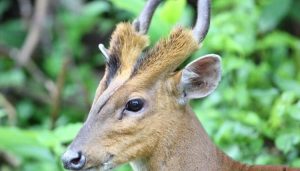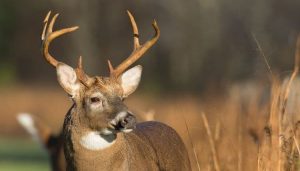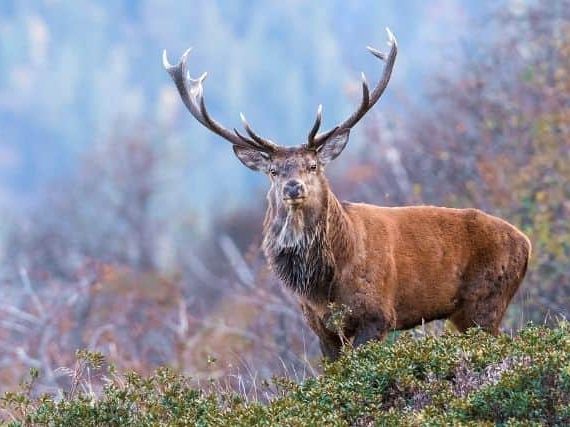If you’ve ever wanted to know all there is to know about eastern roe deer, then this guide is for you.
What is The Siberian Roe Deer?
The Siberian roe deer (Capreolus pygargus) is a species of deer that is native to the northern and central regions of Asia, including Siberia. It is one of the smallest species of true deer, with males (bucks) typically weighing around 60 to 75 kilograms (130 to 165 pounds) and females (does) being slightly smaller.
The Siberian roe deer has a reddish-brown coat in summer and a grayish-brown coat in winter, which helps it blend into its surroundings. It is known for its distinctive white rump patch, which is larger and more prominent in males. Siberian roe deer primarily feed on grasses, leaves, and buds, and they are known for their agility and jumping ability. They are an important game species and are also hunted for their meat and antlers.
What is Eastern Roe Deer Size?
The Eastern roe deer (Capreolus capreolus) is slightly larger than its Siberian counterpart. Male Eastern roe deer, known as bucks, typically weigh between 25 and 45 kilograms (55 to 99 pounds), while females, known as does, usually weigh between 15 and 35 kilograms (33 to 77 pounds). They have a compact body with a short neck and slender legs.
Geographic Range
The Eastern roe deer (Capreolus capreolus) is native to a wide geographic range that spans Europe and parts of Asia. In Europe, it can be found in various countries including the United Kingdom, Ireland, France, Germany, Poland, Russia, and many others. Its distribution extends from the western regions of Europe, such as Portugal and Spain, to the eastern parts, including Russia and the Caucasus region.
Eastern roe deer populations are also present in parts of Asia, including Turkey, Iran, and the western regions of the former Soviet Union. The specific range of the Eastern roe deer may vary within its overall distribution depending on local habitat suitability and historical factors.
Eastern Roe Deer Habitat

Eastern Roe Deer Habitat
The Eastern roe deer (Capreolus capreolus) inhabits a variety of habitats across its range. It is adaptable and can be found in diverse environments, including forests, woodlands, meadows, shrublands, and agricultural areas. Eastern roe deer prefer habitats with a mixture of open areas for grazing and cover for concealment and shelter. They are often associated with edge habitats, such as forest edges or clearings, where they can find a balance between food availability and protection.
In forests, Eastern roe deer can be found in both coniferous and deciduous forests, although they tend to prefer mixed forests with a variety of tree species. They utilize the understory for browsing on shrubs and grasses, while also taking advantage of fallen fruits and nuts. In more open areas, such as meadows and agricultural fields, they graze on grasses, herbs, and crops.
Water sources, such as rivers, streams, and ponds, are also important for Eastern roe deer as they provide drinking water and can serve as natural barriers or boundaries for their home ranges.
Overall, Eastern roe deer exhibit habitat flexibility and can adapt to various landscapes as long as they have access to suitable food sources and cover for shelter and protection.
Siberian roe deer Reproduction -Breeding
The Siberian roe deer (Capreolus pygargus) follows a seasonal breeding pattern, commonly referred to as rutting. The rutting season for Siberian roe deer typically occurs in late July to early August. During this time, male roe deer, known as bucks, engage in intense competition for access to females, known as does.
Bucks establish territories and mark them with scent markings and by thrashing vegetation with their antlers. They also produce vocalizations and engage in aggressive behaviors such as parallel walks and sparring with rival bucks. These displays and contests are aimed at asserting dominance and attracting receptive females.
Once a dominant buck has successfully secured a territory, he will attempt to mate with as many does as possible. Does enter estrus, or the period of sexual receptivity, for a short duration, typically lasting about 24 to 48 hours. During this time, the dominant buck will actively seek out and mate with receptive does.
After mating, a doe undergoes a gestation period of around 280 days, which is roughly nine months. This long gestation period includes a phenomenon called delayed implantation, where the fertilized egg does not immediately implant in the uterine wall. Instead, it remains dormant for several months before implanting and initiating active growth.
In late spring or early summer, the doe gives birth to one or two fawns, which are typically well-camouflaged and have spotted coats to aid in blending with their surroundings. The fawns are nursed by the mother and remain with her until they are weaned at around three to four months of age.
It’s worth noting that the specific timing of breeding and the number of fawns can vary depending on environmental conditions and population dynamics.
How Long Does A Siberian Roe Deer Lifespan?
The lifespan of a Siberian roe deer (Capreolus pygargus) can vary depending on various factors such as habitat conditions, predation pressure, and availability of resources. In general, the average lifespan of a Siberian roe deer in the wild is around 10 to 15 years. However, some individuals have been known to live up to 20 years or more in favorable conditions.
Factors such as disease, predation, hunting, and competition for resources can impact the survival and longevity of Siberian roe deer. Additionally, environmental factors such as severe weather conditions and food scarcity can also influence their lifespan.
It’s important to note that the lifespan of Siberian roe deer in captivity can be longer, with individuals reaching 15 to 20 years or more. In captivity, they are protected from predators and have consistent access to food and veterinary care, which can contribute to their extended lifespan.
Communication And Perception
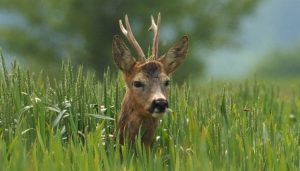
Anti-predator Adaptations
Siberian roe deer (Capreolus pygargus) communicate through a variety of vocalizations, body postures, scent marking, and visual displays. Here are some key aspects of their communication and perception:
Vocalizations: Siberian roe deer produce a range of vocalizations to communicate with each other. These include barks, grunts, whistles, and various calls during the breeding season. These vocalizations are used to attract mates, establish dominance, warn of danger, and maintain contact with other individuals.
Scent marking: Both males and females use scent marking to communicate their presence and reproductive status. They have scent glands on their faces, hooves, and metatarsal glands, which they use to leave scent marks on trees, vegetation, and the ground. This helps in territorial marking and signaling information to other deer in the area.
Body postures and visual displays: During the breeding season, males exhibit aggressive behaviors and visual displays to establish dominance and attract females. This includes parallel walks, thrashing vegetation with antlers, and sparring with rival males. These displays communicate dominance and readiness to mate.
Visual and auditory perception: Siberian roe deer have well-developed senses of vision and hearing. Their large, forward-facing eyes provide a wide field of view and excellent depth perception, aiding in detecting predators and other deer. They also have a keen sense of hearing to detect sounds, including low-frequency vocalizations and the rustling of vegetation.
Olfactory perception: The sense of smell is crucial for communication and perception in roe deer. They have a highly developed olfactory system and use scent cues to identify individuals, determine reproductive status, mark territories, and detect potential threats.
Interspecies communication: Siberian roe deer also interact with other species in their habitat. They may respond to alarm calls from other animals, such as birds or squirrels, which can signal the presence of predators. They also interact with their predators, such as wolves and lynx, through defensive behaviors and alarm signals.
In summary, Siberian roe deer communicate through a combination of vocalizations, scent marking, body postures, and visual displays. Their well-developed sensory perception allows them to gather information about their environment, detect threats, establish social hierarchies, and communicate reproductive status within their species.
What Do Eastern Roe Deer Diet?
Eastern roe deer (Capreolus capreolus) are herbivores, and their diet primarily consists of plant materials. They are selective feeders and consume a variety of vegetation based on seasonal availability. Here are some key components of the Eastern roe deer’s diet:
-
Grasses: Grasses form a significant part of the Eastern roe deer’s diet. They feed on a variety of grass species, including both tall grasses and shorter, more nutritious grasses found in meadows and open areas.
-
Herbaceous plants: Eastern roe deer also consume a wide range of herbaceous plants, including leafy plants, herbs, and forbs. They feed on the leaves, stems, and flowers of these plants.
-
Shrubs and woody plants: Roe deer browse on the twigs and leaves of shrubs and small woody plants. They may consume various shrub species, including hawthorn, blackthorn, rose, and bramble.
-
Tree foliage: Eastern roe deer can feed on the foliage of certain tree species, especially in the winter when other food sources may be scarce. They may browse on the leaves and twigs of trees such as birch, willow, aspen, and oak.
-
Crops: In areas where agricultural fields are present, Eastern roe deer may feed on crops such as wheat, barley, oats, and maize. This can lead to conflicts with farmers, as they can cause damage to crops.
The specific composition of the Eastern roe deer’s diet can vary depending on factors such as habitat, seasonal availability of food, and local plant species. They have a relatively diverse diet and can adapt to different food sources based on availability and nutritional content.
Anti-predator Adaptations
Eastern roe deer (Capreolus capreolus) have evolved several anti-predator adaptations to increase their chances of survival and avoid predation. Here are some notable adaptations:
-
Camouflage: Roe deer have a coat coloration that provides effective camouflage in their natural habitats. Their reddish-brown or grayish-brown fur blends with the surrounding vegetation, helping them remain concealed from predators.
-
Alertness and vigilance: Eastern roe deer have well-developed senses, including keen eyesight and acute hearing. They are constantly alert, scanning their surroundings for signs of predators. Their large, forward-facing eyes provide a wide field of view, enabling them to detect potential threats from different directions.
-
Speed and agility: When faced with immediate danger, roe deer rely on their remarkable speed and agility to evade predators. They can reach speeds of up to 40-50 kilometers per hour (25-30 miles per hour) in short bursts and maneuver quickly through dense vegetation or obstacles.
-
Escape strategies: Roe deer are adept at employing escape strategies to avoid predation. They often rely on their agility to zigzag or change direction rapidly, making it difficult for predators to pursue them. They can also utilize their smaller size to their advantage by slipping through narrow gaps or dense vegetation that larger predators may struggle to navigate.
-
Alarm signals: Eastern roe deer have a variety of vocalizations and alarm signals to alert nearby individuals of potential danger. When a roe deer detects a predator, it can emit a loud barking sound, signaling a warning to other deer in the area.
-
Group behavior: Roe deer sometimes form small social groups, especially during the winter months. Being in a group provides them with increased vigilance and the ability to detect predators more effectively. If a predator is spotted, individuals in the group may coordinate their actions to evade or confront the threat.
-
Scent marking and avoidance: Roe deer use scent marking to establish territories and communicate with other individuals. They also possess the ability to detect the scent markings of predators and adjust their behavior accordingly, avoiding areas where predator scent is strong.
These anti-predator adaptations collectively enhance the Eastern roe deer’s chances of survival by improving their ability to detect, evade, and deter predators in their environment.
Ecosystem Roles
Eastern roe deer (Capreolus capreolus) play important ecosystem roles within their habitats. Here are some of their key roles:
-
Herbivory: As herbivores, roe deer contribute to shaping plant communities by consuming various vegetation. Their feeding behavior influences plant species composition, nutrient cycling, and growth patterns. They help control vegetation density and promote diversity by selectively browsing certain plants, which can impact the structure and composition of plant communities.
-
Seed Dispersal: Roe deer can act as seed dispersers by consuming fruits, seeds, and berries from various plant species. They may transport seeds over distances and deposit them in new locations through their feces. This aids in the dispersal and colonization of plant species, contributing to plant populations’ regeneration and genetic diversity.
-
Grazing Patterns: The foraging behavior of roe deer, such as selective browsing, can shape the structure and distribution of plant communities. Their feeding preferences and patterns can affect the growth, survival, and competitive interactions among plant species. This can influence vegetation dynamics and the availability of resources for other herbivores and plant-eating species.
-
Prey for Predators: Eastern roe deer serve as prey for a variety of predators, including wolves, lynx, bears, and large raptors. They form an important component of the food web, providing a vital food source for these carnivores and helping maintain predator populations and their ecological interactions.
-
Indicator Species: The presence and behavior of roe deer can provide valuable information about the health and integrity of ecosystems. Changes in their population density, behavior, or distribution can indicate shifts in habitat quality, availability of resources, or impacts from human activities. Monitoring roe deer populations can help assess the overall well-being of the ecosystems they inhabit.
-
Trophic Interactions: Through their herbivory, roe deer can influence the abundance and availability of resources for other organisms within the ecosystem. They can indirectly impact other herbivores, such as by competing for food resources or modifying vegetation structures. These trophic interactions can have cascading effects on other species and ecosystem dynamics.
Conservation Status
The conservation status of the Eastern roe deer (Capreolus capreolus) varies depending on the specific populations and regions. Overall, the species is not globally threatened and is categorized as of “Least Concern” by the International Union for Conservation of Nature (IUCN). However, it’s important to note that regional populations may face localized threats and conservation concerns.
The Eastern roe deer has a relatively wide distribution across Europe and parts of Asia. It is adaptable to various habitats, including forests, meadows, and agricultural areas, which has contributed to its population stability and resilience.
Conservation efforts for the Eastern roe deer primarily focus on habitat conservation, wildlife management, and addressing specific threats to local populations. These threats can include habitat loss and fragmentation due to land development, agricultural expansion, and urbanization. Additionally, illegal hunting and poaching can pose challenges in certain areas.
Conservation measures typically involve establishing protected areas and wildlife management practices that promote sustainable hunting, habitat restoration, and population monitoring. Collaboration between governmental agencies, conservation organizations, and local communities is crucial for the successful conservation of Eastern roe deer populations.
How Fast Can An Eastern Roe Deer Run?
Eastern roe deer (Capreolus capreolus) are known for their agility and speed when it comes to evading predators or escaping potential threats. They are capable of reaching impressive speeds for short distances. On average, an Eastern roe deer can run at a speed of around 40 to 50 kilometers per hour (25 to 30 miles per hour).
Their running speed allows them to quickly cover ground and navigate through various terrains, including dense vegetation, forests, and open fields. They can make sudden changes in direction and use their agility to evade predators or potential dangers. However, their sustained speed is typically lower, and they rely more on their ability to maneuver and take advantage of their environment to escape threats effectively.
Population
The eastern roe deer population is estimated at between 15-25 million.
What is the difference between a deer and a roe deer
Roe deer have a dark brown or black-brown coat in the summer and are lighter in color in the winter. They have white bellies and white spots on their necks and rumps.
Deer are a term used for many different species of ungulate mammals from the family of Cervidae, which includes animals such as African wild ass, fallow deer, caribou, moose, reindeer, and others.
Are roe deer protected in the UK?
The eastern roe deer have been protected in the UK since 1991. In addition to that, it is also protected in Europe, Russia, and Scandinavia.
What trees do roe deer like to eat?
The study also showed that Eastern roe deer are more likely to eat three types of trees: beech, tulip poplar, and willow.
Where do eastern roe deer sleep
Eastern roe deer sleep under a thick bed of leaves, moss, lichens, and twigs. They like to use natural materials as their bed.
What plants do eastern roe deer avoid?
Plants Eastern Roe Deer Avoid:
-Dill
-Parsley
-Peppermint
-Sagebrush
-Sage
Can Eastern Roe Deer Swim?
The answer is yes; eastern roe deer can swim!
İs Eastern Roe Deer Aggressive?
Eastern roe deer are aggressive animals. They typically have large antlers that they use during fights.

